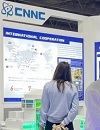 |
||
|
Duan Xuru: Continuously develop nuclear fusion technology and accelerate the process of energy transition CNNC, PUBLISHED 30.03.2024 Controllable nuclear fusion has been considered as the best solution to human's energy problem. On February 29, the International Thermonuclear Experimental Reactor (ITER) organization signed a contract with the China-French consortium led by CNPE for assembling the vacuum chamber module. It is the second time that China has undertaken the task of installing ITER's core equipment. The international development of nuclear fusion energy has entered a new stage Duan Xuru, a national political adviser and chief expert with the CNNC in the field of nuclear fusion reactor technology, said that since the entry of the ITER project, China has made great strides in the further improvement of its relevant scientific prowess. Breakthroughs have been continuously made in the research of controllable nuclear fusion and key technologies of fusion reactor, with some advancements reaching the forefront in the international stage. Meanwhile, the country has fostered a number of high-caliber talents with international perspectives and built several internationally advanced research and development platforms. Currently, the research focus is on fusion plasma experiments, fusion reactor design and engineering technology. Active planning is underway for deuterium and tritium burning plasma experiments, accelerating the progress towards the experimental reactor engineering phase. In recent years, major nuclear countries around the world have made efforts in nuclear fusion energy research. In 2019, the China-French consortium led by CNPE won a bid for the first-phase installation of primary components of the ITER, signifying international recognition of China's nuclear fusion technology and laying a scientific and technological foundation for the country's further involvement in the operation of the ITER and the independent design and construction of the experimental reactor. Judging from China's valuable experience in the development of the nuclear industry, it is a natural law to promote the building of experimental nuclear reactors, demonstration nuclear reactors and then commercial reactors progressively in the application of nuclear energy. Therefore, China shall solidly advance through each stage. It is anticipated that in another 20 to 30 years, the "artificial sun" will provide a new type of energy that is low-carbon, efficient, and safe. Industrial integration promotes the construction of a new energy system Currently, artificial intelligence has gradually become involved in nuclear fusion research, showing a trend towards deep integration. In recent years, it has been applied to such areas as plasma operation monitoring and achieved remarkable results. Overall, the application of AI technology in nuclear fusion research is in its early stage with significant potential for development. Its advantage in handling big data can fundamentally accelerate the nuclear fusion research process by helping analyze experimental results. There are still numerous challenges in achieving the utilization of nuclear fusion energy. China will leverage its strengths, coordinate resources, and concentrate efforts on tackling key technologies. It will fully harness the role of industrial sectors and groups, leveraging the industrial advantages of enterprises to enhance the efficiency of industry-academia-research cooperation. This will advance the country's high-quality development in the nuclear fusion energy. With the advancement of science and technology and the improvement of people's living standards, existing energy sources, mainly represented by fossil fuels, will not be able to meet the needs of economic and social development. Nuclear fusion energy, with its advantages of abundant resources, environmental friendliness, and safety, is recognized as an important approach to tackle energy and environmental problems. It is expected that fusion energy will become more accessible in the future, and play an important role in ensuring China's energy security and promoting the realization of the country's "dual carbon" goal as well as the construction of a new energy system. It is necessary to push forward relevant legal building The Linglong One is a new-type commercial small modular reactor independently developed by the CNNC on the basis of mature pressurized water reactor and nuclear power technology. It is the world's first small modular pressurized water reactor to pass the general safety review of the International Atomic Energy Agency (IAEA). The construction of the Linglong One reactor is progressing smoothly. It is expected to go into operation as scheduled in 2026. It will have an annual power generation capacity of 1 billion kWh, enough to meet the power needs of 526,000 households. It will reduce the emission of 880,000 tons of CO2 annually, which is equivalent to the planting of 7.5 million trees. As a representative of nuclear energy innovation, the small modular reactor (SMR) has advantages such as diverse applications, flexible deployment, environmental friendliness and high safety. It has excellent development prospects. It has become an industrial consensus in promoting its multi-purpose utilization. The SMR is not only an ideal heat source for combined cooling, heating and power (CHPC) system, but also can be used for nuclear hydrogen production, desalination, and other purposes. It will complement large-scale pressurized water reactors, assist in the construction of a new energy system, and facilitate the clean and low-carbon transformation of industries with high energy consumption and heavy carbon emissions. It will make significant contributions to the realization of China's "dual carbon" goal. Currently, the regulation system for project approval and accident handling of the SMR shall still need to be improved. The building and improvement of safety-related regulations and relevant standards will facilitate the high-quality development of the SMR industry. Topics: Asia, China, Opinions, Fusion Other news: 415 nuclear units are operating in the world 57 units are under construction. HTR-PM starts commercial operation It is an important pathway for optimizing energy structure, ensuring reliable energy supply, and contributing to the dual carbon goal. Lepse Floating Technical Base Dismantlement Project has been successfully implemented To discharge spent nuclear fuel, the Lepse was placed in a specially designed and built onshore sheltering site. This made it possible to prevent any weather effects. |
Hero of the day 
The Forum, which became the 13th one, set a record in terms of the number of participants - about 4,500 from 75 countries (ten greater than in 2022). The event was honored by the presence of representatives of business, government agencies, and international organizations. INTERVIEW
CNNC OPINION
Han Yongjiang |

